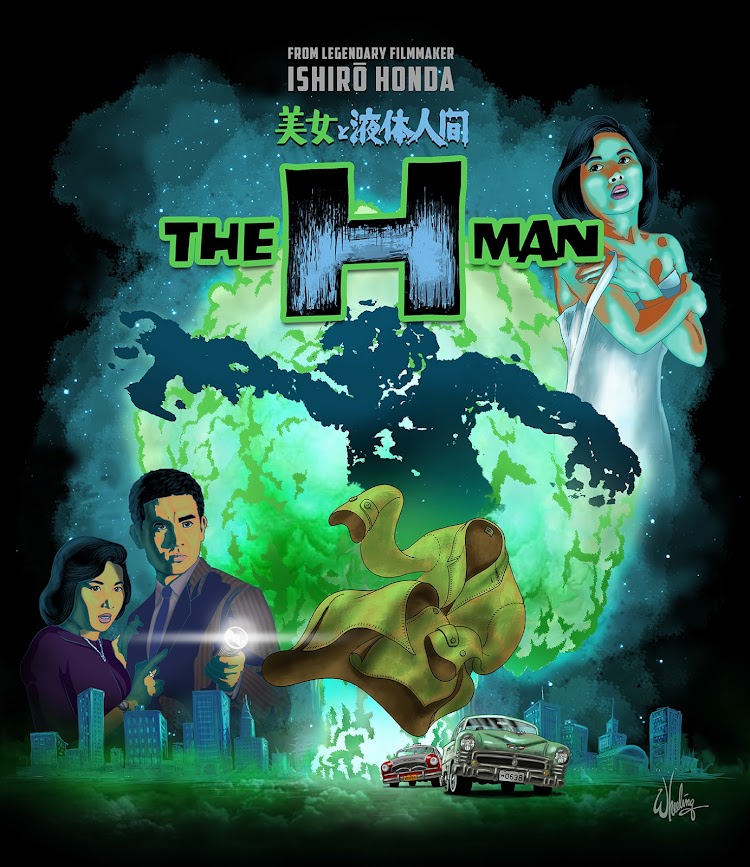Honda’s 1959 space-invaders-attack-the-earth sci-fi
extravaganza BATTLE IN OUTER SPACE, contains reused elements, slightly modified model ships and even
character names, from Honda’s earlier 1957 film THE MYSTERIANS, but is
generally considered only a very “loose” sequel, if at all. With that in mind I
could approach this design with no need to tie it into that film. BUT, this
being sold as DOUBLE FEATURE meant I had to find a design that worked well set
beside a vastly different film altogether, THE H-MAN. Which is a 1958 sci-fi noir
thriller, dealing with
It’s always a challenge to find a cohesive and clever way to meld two different films into a single design. Especially two slightly different genres. Sure I could retrofit two posters side-by-side with little effort. Boring. As nice as the original poster art is, and it is cool, that is not what I'm being paid to do. None of these characters are consistent between the films so finding a single protagonist to represent both films (ala Wong Fei-hung in Tsui Hark’s ONCE UPON A TIME IN CHINA series) won’t work either.
I got to thinking… (I know, never a good sign.)
What if the whole was something more than the sum if it’s parts? What if the two films together could somehow create a new image (sort of a MAD Magazine fold-in). What if they conveyed a greater understanding of Honda’s talents than did each film alone.
To that end I decided to try to blend the two “half” images (representing each movie) together to form something more cohesive.
The left side would feature a circular mushroom cloud with the vertical shaft of the cloud extending straight down underneath. The right side would be a half moon, the same size as the hydrogen bomb cloud. A carefully positioned rocket would mimic the shaft of the explosion, the baseline ground level would line up, and bingo bango jig-a-jog jango, the two images would together create two halves of the same shape. Well, worth a try anyway.
Anyway, below is the final cover used.
Then THE- H-MAN came next and was more straight forward to do. Once I knew the size I needed to draw the mushroom cloud and the ground level (and that the sky was now black) it all came together easily. I digitally recreated the films title logos from poster references and gave each film its own color theme.
Oddly enough, after living with this design for a bit, I eventually decided I DIDN’T like the moon rocket cut in half and moved it over to the right. This compromised the initial intent of the composition, but I can’t be tied to any idea, no matter how clever I thought it was, if it’s hurting the overall work. I have to let go if something better comes along. The work is not finished until I send it out to the printer. Usually stepping away from the work for a bit and then returning gives me fresh impressions which can illuminate areas of the art that should be addressed. Sure, you can kill it with improvements. But the more I looked it at, the more I felt it might be seen as a mistake to have the rocket halved right in the middle of the "canvas". So below is the version that finally went to print.
I retrofitted the artwork for use as menu backgrounds and even
did WRONG REGION CODE NOTICE backgrounds you only see if your Blu-ray player is
set to any region other than 2. I also created white versions of the menus for
It was a fun project as I love 1950s sci-fi, physical media, Blu-ray and Japanese cinema of that period. So combining these elements, and getting paid in the process, was a dream come true. I’ve long considered writing a chronological reference book on 1950s sci-fi/fantasy cinema, but with my limited time this may be as close as I get. For a while anyway.
Next time... we meet the KING BOXER. But
don't look him straight in the eyes.













No comments:
Post a Comment